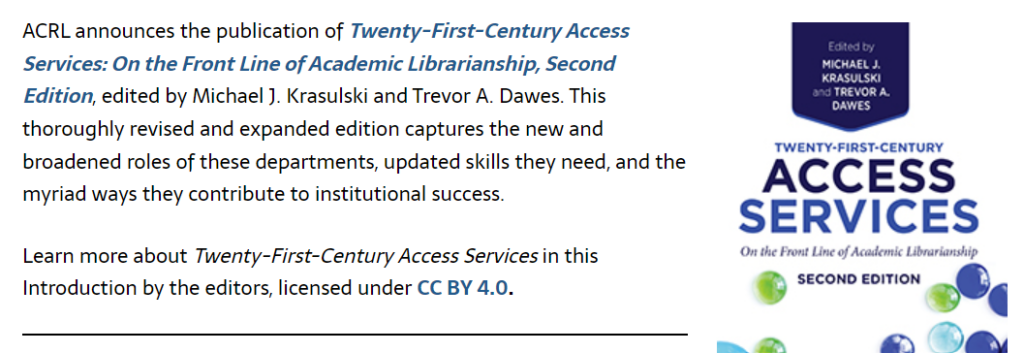Back in November of 2020, Michael Krasulski (Philadelphia Community College) approached Justin Hill and me about contributing to a new edition of ACRL’s Twenty-First Century Access Services. The 2013 edition was in desperate need of a refresh – so much has changed in the ways that we manage our collections and provide services to users.
Justin and I worked furiously to get our chapter submitted on time, and two years later, we were thrilled to see this announcement:

We can’t wait to read the entire volume, but in the meantime, we share some key points from our own chapter on assessment. We structured our section as a series of questions:
How do we get started with assessment?
- Start your assessment journey by identifying and getting to know the data you currently collect and have easy access to: Circulation statistics, interlibrary loan data, user feedback, space use statistics. Make sure you have a systematic, centralized approach to data collection and retention.
How do we compare to our peer institutions?
- Learn about the external surveys your library is contributing to: ARL, ACRL, PLA, IPEDS, and use these datasets of comparative data for peer analysis. Consider comparing ratios, like circulation rate per student FTE, study carrel use by school and college. These will be more useful to you than just counting transactions. Consider your purpose. Are your peers institutions like your own in terms of size or budget, or are they aspirational peers – libraries you’d like to emulate?
How do we best manage our local collections?
- Analyze data on circulation, in-house and reserve material use to establish patterns of usage.
- For instance, understanding peak times for circulation of physical materials can inform staffing models at the service desk.
- Usage patterns by specific user populations may suggest unidentified needs and potential for new services.
How can we expand access to content for our community?
- Interlibrary loan data can shed light on gaps in the local collection and guidance for the selection of e-journal backfiles for purchase.
- Solicit feedback from users through suggestion forms, conversations with faculty, and regular collaboration with liaison libraries to share insights about disciplinary trends.
How can we be more efficient in our workflow?
- Get together staff around a whiteboard and diagram a complicated access services process. Figure out the pain points. Temple Libraries explored its Rush Reserves process using this approach; that project is profiled here: Rush Reserves: A Collaborative Workflow Analysis – a simple model that yields good results.
How can we improve the user experience?
- How is the library experienced by a first-year student? Imagine navigating the Library of Congress shelving system for the first time. To learn more about how services can be improved for users, consider usability testing, focus groups, observation, or applied ethnography. An excellent model is the work done at the University of Rochester: Studying Students: The Undergraduate Research Project.
What is the story we want to tell?
- Find captivating ways of telling your libraries’ story. Many libraries, both public and academic, use data dashboards to show the public what they are doing. Data awareness can also be a staff training issue – Kennesaw State University applied a scaffolded approach to training staff, with beginners using Excel to apply replacement costs to lost items, to advanced, preparing analysis for sharing with administration.
How do we develop an organization where assessment thrives?
- Assessment thrives in organizations that encourage continuous improvement and are willing to change based on evidence. A culture of assessment is supported by sharing data and assessment findings openly, using those findings to generate new questions, and taking a collaborative, team-based approach that helps to break down silos in the organization.
While getting from draft to final publication seemed like an eternity, Justin and I think our chapter on assessment in access services will be a valuable contribution to our colleagues in the field – it’s meant to start library staff thinking about the many ways they can improve services to our communities, as well as empower staff at all levels to engage with these questions.
Our chapter provides extensive examples, references and links. While we can only hope that those links still work, we’re confident that the general guidance we provide remains sound and relevant until it’s time for ACRLL to publish the third edition.
